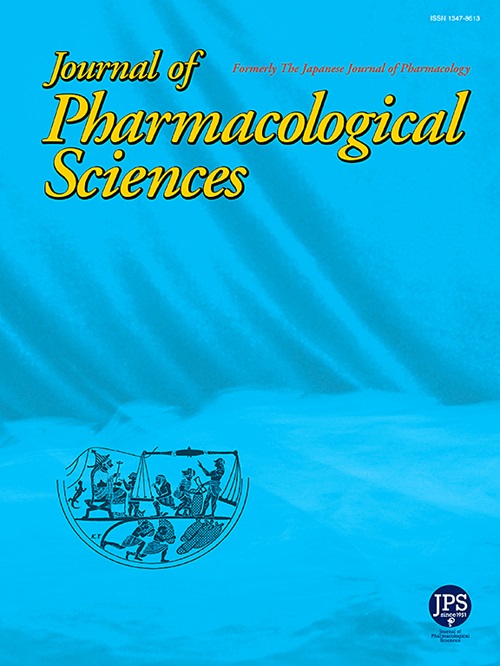新型PDE9抑制剂KR39526和KR39582可减轻压力过载引起的心脏肥大和纤维化
IF 2.9
3区 医学
Q2 PHARMACOLOGY & PHARMACY
引用次数: 0
摘要
利钠肽和环鸟苷单磷酸(cGMP)级联是治疗心力衰竭的理想靶点。本研究评估了新型磷酸二酯酶9 (PDE9)抑制剂KR39526和KR39582的体外和体内药理特性和心脏保护作用。通过PDE9抑制活性和亚家族选择性测定来评估这些化合物的效价和选择性。心肌细胞的功能分析包括钙动员、细胞肥大和蛋白表达。采用压力过载致心肌肥厚小鼠模型研究其心脏保护作用。KR39526和KR39582表现出较强的PDE9A抑制活性(IC50分别为5±2 nM和0.4±0.1 nM),具有较高的选择性。这种抑制作用通过维持细胞内cGMP水平导致浓度依赖性钙内流,并显著抑制苯肾上腺素诱导的心肌细胞肥大。口服50 mg·kg-1可显著减轻压力过载引起的心肌肥厚和心肌纤维化。这些结果表明,KR39526和KR39582作为有效的、选择性的PDE9A抑制剂,在心力衰竭中具有很强的抗肥厚和抗纤维化作用。这些化合物可以作为有价值的药理学工具来阐明PDE9A信号在心力衰竭病理生理中的作用,并作为潜在的治疗药物具有重要的前景。本文章由计算机程序翻译,如有差异,请以英文原文为准。
Novel PDE9 inhibitors, KR39526 and KR39582, attenuate cardiac hypertrophy and fibrosis induced by pressure overload
The natriuretic peptide and cyclic guanosine monophosphate (cGMP) cascade are promising therapeutic target for heart failure. This study evaluated the pharmacological properties and cardioprotective effects of novel phosphodiesterase 9 (PDE9) inhibitors, KR39526 and KR39582, in vitro and in vivo. The potency and selectivity of these compounds were assessed through PDE9 inhibitory activity and subfamily selectivity assays. Functional analyses in cardiomyocytes included calcium mobilization, cellular hypertrophy, and protein expression. The cardioprotective efficacy was investigated using a mouse model of pressure-overload-induced cardiac hypertrophy. KR39526 and KR39582 demonstrated potent PDE9A inhibitory activities (IC50: 5 ± 2 nM and 0.4 ± 0.1 nM, respectively) with high selectivity. This inhibition led to concentration-dependent calcium influx through maintaining intracellular cGMP levels and significantly suppressed phenylephrine-induced cardiomyocyte hypertrophy. Oral administration (50 mg·kg-1) of these compounds markedly attenuated cardiac hypertrophy and myocardial fibrosis induced by pressure overload. These results suggest that KR39526 and KR39582, as potent and selective PDE9A inhibitors, have strong potential for exerting anti-hypertrophic and anti-fibrotic effects in heart failure. These compounds can serve as valuable pharmacological tools to elucidate the roles of PDE9A signaling in heart failure pathophysiology and hold significant promise as potential therapeutic agents.
求助全文
通过发布文献求助,成功后即可免费获取论文全文。
去求助
来源期刊
CiteScore
6.20
自引率
2.90%
发文量
104
审稿时长
31 days
期刊介绍:
Journal of Pharmacological Sciences (JPS) is an international open access journal intended for the advancement of pharmacological sciences in the world. The Journal welcomes submissions in all fields of experimental and clinical pharmacology, including neuroscience, and biochemical, cellular, and molecular pharmacology for publication as Reviews, Full Papers or Short Communications. Short Communications are short research article intended to provide novel and exciting pharmacological findings. Manuscripts concerning descriptive case reports, pharmacokinetic and pharmacodynamic studies without pharmacological mechanism and dose-response determinations are not acceptable and will be rejected without peer review. The ethnopharmacological studies are also out of the scope of this journal. Furthermore, JPS does not publish work on the actions of biological extracts unknown chemical composition.

 求助内容:
求助内容: 应助结果提醒方式:
应助结果提醒方式:


